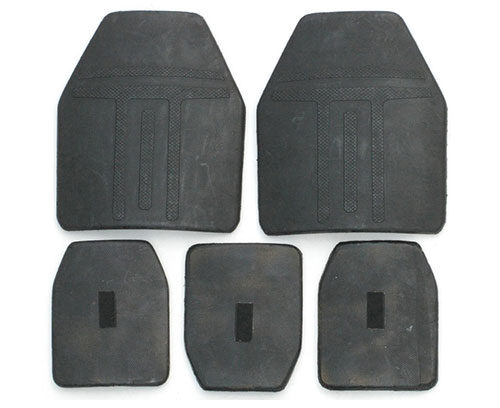Silicon carbide bulletproof ceramics, an essential material in the field of ballistic protection, continuously demonstrates its unique performance and the pivotal role of its manufacturing process in its application and research.

I. Structure and Performance of Silicon Carbide Crystals
Silicon carbide crystallizes in Si-C tetrahedral stacks, existing in two forms: α and β. At sintering temperatures below 1600℃, SiC appears as β-SiC; when the sintering temperature exceeds 1600℃, β-SiC slowly transforms into α-SiC. The covalent bonds of α-silicon carbide are exceptionally robust, retaining high-strength bonding even at high temperatures. This structural feature endows silicon carbide ceramics with outstanding properties, including exceptional strength, high hardness, wear resistance, corrosion resistance, high thermal conductivity, and excellent thermal shock resistance. Simultaneously, silicon carbide ceramics are moderately priced, offering exceptional value, positioning them as high-performance ballistic materials with significant development potential.
II. Forming Methods and Characteristics of Silicon Carbide Ceramics
Multiple forming methods are employed in the preparation of silicon carbide ceramics, encompassing molding, slurry molding, cold isostatic pressing, gel casting, among others. Each method possesses unique characteristics; for instance, molding techniques are simple, efficient, and suitable for continuous high-yield production. Meanwhile, slurry molding exhibits strong adaptability, enabling the fabrication of various shapes and structured bodies, presenting significant advantages in producing irregular silicon carbide ceramic components.
III. Sintering Process and Comparative Analysis of Silicon Carbide Ceramics
The sintering process stands as a crucial stage in the production of silicon carbide ceramics. Presently, sintering methods include reaction sintering, hot pressing, hot isostatic pressing, and pressureless sintering. Each method holds distinct features; for instance, reaction sintering enables the production of large-sized, intricate components. However, inherent defects result in an inevitable presence of 8% to 12% free silicon in the material, diminishing its high-temperature mechanical performance and corrosion resistance.
IV. Technical Advantages of Multi-Curved Silicon Carbide Bulletproof Panels
Manufacturing silicon carbide bulletproof panels poses technical challenges for multi-curved products. Leveraging advanced molding and sintering equipment alongside mature pressureless sintering technology for silicon carbide ceramics, Sanxin Advanced Materials has successfully developed multi-curved silicon carbide bulletproof panels. These products not only excel in protective performance but also present greater possibilities in terms of product shapes and dimensions.
V. Technological Innovation and Prospects in Market Applications
In the realm of silicon carbide bulletproof ceramics, ongoing technological innovations consistently drive the advancement of product performance and production processes. Looking ahead, with the increasing demand in the ballistic protection domain, the market prospects for silicon carbide ceramics are poised to broaden. Sanxin Advanced Materials remains committed to continuous technological innovation, propelling the widespread application of silicon carbide bulletproof ceramics across multiple domains.

Submit your demand,
we will contact you ASAP.

Sanxin New Materials Co., Ltd. focus on producing and selling ceramic beads and parts such as grinding media, blasting beads, bearing ball, structure part, ceramic wear-resistant liners, Nanoparticles Nano Powder

